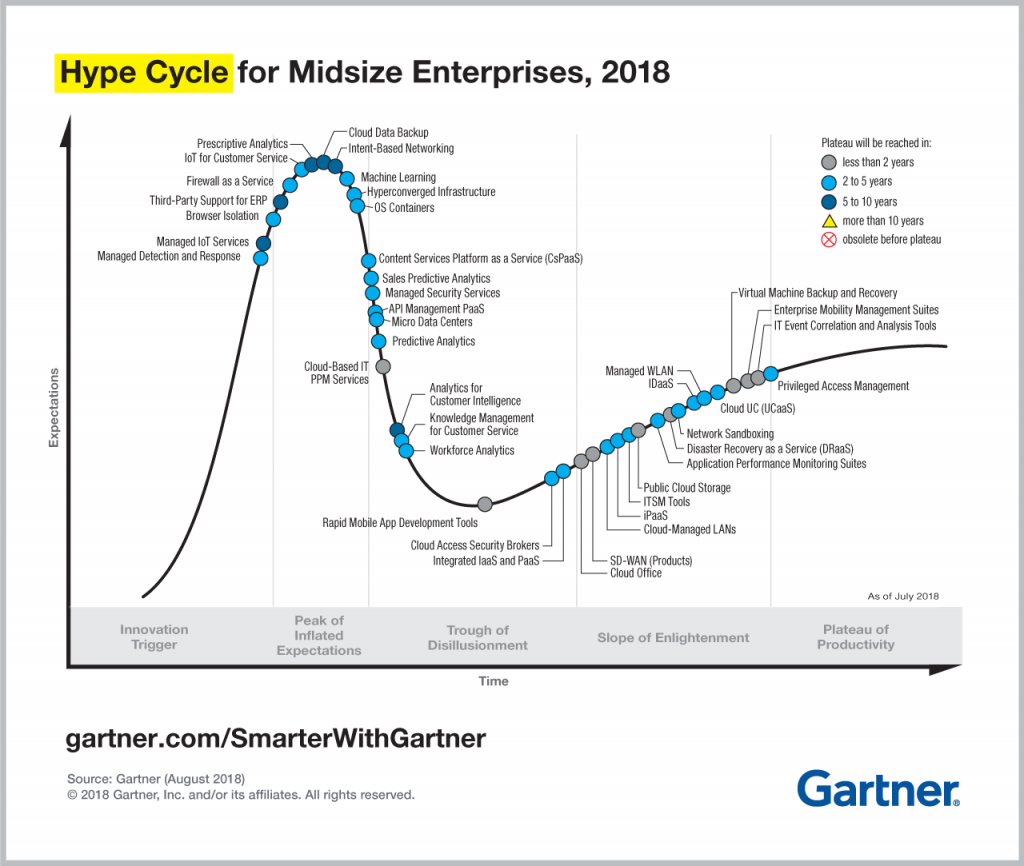Why midsize enterprise CIOs need to move forward with SD-WAN, Cloud UC, machine learning and DRaaS.
In the event that a hurricane temporarily takes a data center offline, flooding makes it impossible for employees to access the physical site or an unexpected outage occurs, midsize enterprises (MSEs) should be prepared.
The Midsize Enterprise Hype Cycle is divided into two categories — mature technologies that have low adoption rates, and less-mature technologies of which midsize enterprises can be early-adopters. Disaster Recovery as a Service (DRaaS) is one of the technologies placed on the low-risk/mature category.
Generally, CIOs at MSEs should be focused on aligning their strategic agendas with top business priorities while creating technology ecosystems that deliver required IT services using the fewest resources.
“The economic, cultural, technical and managerial characteristics of MSEs weigh heavily on IT decision making as plans to address the dynamic business demand for IT services are developed,” says James Browning, vice president and distinguished analyst at Gartner.
“Fortunately, adaptive approaches and emerging technologies make it cost-effective for MSEs to rapidly source and deliver business services, even with fewer resources. To keep pace with the rapid rate of business and technology change, MSEs must exploit their advantage to adapt quickly and leverage technology to improve business outcomes.”

Mature/low-risk technologies for MSEs
The mature technologies are low risk, but are underutilized and being adopted at slower rates than they should be by MSEs. Enterprises should use DRaaS and similar technologies to optimize IT operations, improve resiliency and enhance business capabilities.
Disaster Recovery as a Service (DRaaS)
DRaaS is a cloud-based recovery system in which the service provider manages virtual machine replication, virtual machine activation and recovery exercise orchestration. Gartner estimates DRaaS worldwide revenue will be $2.4 billion in 2018 and will grow to $3.7 billion by 2022, with more than 500 providers. The strongest growth is in smaller enterprises, with more recent growth in enterprises with 1,000 to 5,000+ employees.
DRaaS is a good option for companies that need disaster recovery capabilities for existing Windows- or Linux-based production applications, those that require a formally managed recovery service level, or in cases where the alternative for recovery would require additional servers and storage equipment.
SD-WAN
Software-defined networking in a wide-area network (SD-WAN) enables enterprises to create simpler and more cost-effective branch office WANs that map to modern application and cloud architecture. This is an increasingly popular technology — over 6,000 Gartner clients are deploying SD-WAN products in production networks.
New SD-WAN solutions have introduced viable lightweight alternatives to traditional branch office routers and are better suited to the predominantly WAN traffic patterns found in today's business environment. SD-WANs enable MSEs to shift an increasing amount of WAN traffic to internet circuits, allowing them to optimize the costs of MPLS services and create a much simpler operational environment, thus reducing time spent managing the WAN by 50% or more.
Cloud UC
Unified communications as a service (UCaaS), or Cloud UC, are services that offer all communications for the company, including instant messaging, unified messaging, meeting solutions, collaboration and mobility. Given the limited IT resources and skill sets, Cloud UC can be a good fit for smaller enterprises. The current market offers a variety of providers, and the enterprise will benefit from a faster pace of innovation than the enterprise might otherwise be able to support.
Opportunity technologies
On the left side of the Hype Cycle are the less-mature technologies. MSEs can exploit inherent advantages such as a smaller scale and ability to move faster to become first movers for some emerging technologies.
Managed security services
Managed security services (MSSs) offer a range of security capabilities and are being used by MSEs to offload routine security functions. MSEs use MSSs as extensions of their IT staff rather than adding security head count. Managed security service providers (MSSPs) can provide these services on a 24/7 basis, which is not achievable for MSEs with scarce security skills. An MSS is also an effective way for MSEs to adopt detection and response capabilities to complement their investments in preventive security controls.
Machine learning
Machine learning uses mathematical models to extract knowledge and patterns from data, which can then be applied to business problems. This technology is becoming increasingly important as businesses encounter a level of volume and data complexity that conventional engineering cannot handle. Most organizations are still at the beginning of the process. However, those that are interested should begin with simple business problems with an expected outcome and then move toward more complex scenarios.


